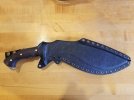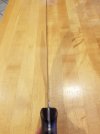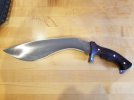Kailash Blades
Knifemaker / Craftsman / Service Provider
- Joined
- Nov 21, 2015
- Messages
- 1,089
Hey there guys! Up for grabs today is a scourge anniversary with the following options:

Due to our differential hardening the main body of our knives is quite soft, meaning that it can bend and take a set quite readily- in this case the blade got to our 1st QC check straight and then developed a bit of twist after seeing uneven forces in our kydex press. This wasn't caught in our pre shipping qc check and made its way to the US. Here's a photo of this twist:

As you may be able to see the belly portion of the edge pulls a few mm (3ish?) to the left. The spine is generally straight and within spec. There are no other issues with the blade.
This misalignment should not impact durability but may lead to it pulling slightly to the right during deep cuts. If taking chops at a branch or sapling from alternating directions you may need to adjust the angle of cut on one side for completely even results.
If you're handy in the workshop this could likely be straightened by clamping the ricasso in a big vice then clamping the belly between two planks of wood and twisting- as stated previously our blades take a set very readily.
Buyers from North America only for this one. Cost is 145 usd before shipping.
if you're interested in picking up this quirky little number send us a DM or email
Hope everyone enjoys the rest of their week!
- Blade Finish: Satin
- Handle material: Indian Rosewood
- Sheath: Kydex
- Kydex Colour: Black
- Grind Type: Standard Grind


Due to our differential hardening the main body of our knives is quite soft, meaning that it can bend and take a set quite readily- in this case the blade got to our 1st QC check straight and then developed a bit of twist after seeing uneven forces in our kydex press. This wasn't caught in our pre shipping qc check and made its way to the US. Here's a photo of this twist:

As you may be able to see the belly portion of the edge pulls a few mm (3ish?) to the left. The spine is generally straight and within spec. There are no other issues with the blade.
This misalignment should not impact durability but may lead to it pulling slightly to the right during deep cuts. If taking chops at a branch or sapling from alternating directions you may need to adjust the angle of cut on one side for completely even results.
If you're handy in the workshop this could likely be straightened by clamping the ricasso in a big vice then clamping the belly between two planks of wood and twisting- as stated previously our blades take a set very readily.
Buyers from North America only for this one. Cost is 145 usd before shipping.
if you're interested in picking up this quirky little number send us a DM or email
Hope everyone enjoys the rest of their week!
